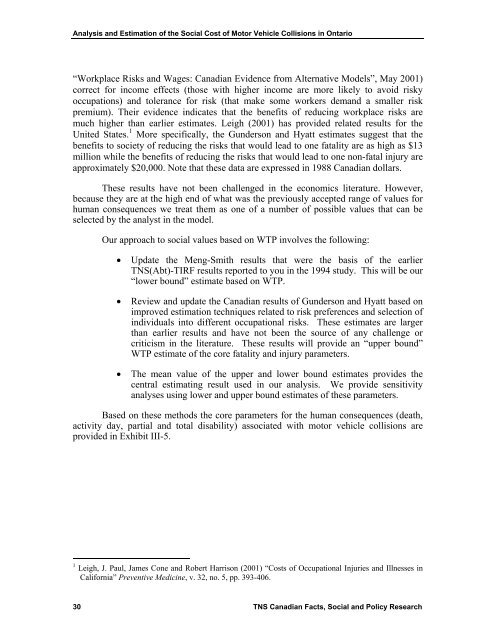Keith Vodden Dr. Douglas Smith - Transports Canada
Keith Vodden Dr. Douglas Smith - Transports Canada
Keith Vodden Dr. Douglas Smith - Transports Canada
You also want an ePaper? Increase the reach of your titles
YUMPU automatically turns print PDFs into web optimized ePapers that Google loves.
Analysis and Estimation of the Social Cost of Motor Vehicle Collisions in Ontario<br />
“Workplace Risks and Wages: Canadian Evidence from Alternative Models”, May 2001)<br />
correct for income effects (those with higher income are more likely to avoid risky<br />
occupations) and tolerance for risk (that make some workers demand a smaller risk<br />
premium). Their evidence indicates that the benefits of reducing workplace risks are<br />
much higher than earlier estimates. Leigh (2001) has provided related results for the<br />
United States. 1 More specifically, the Gunderson and Hyatt estimates suggest that the<br />
benefits to society of reducing the risks that would lead to one fatality are as high as $13<br />
million while the benefits of reducing the risks that would lead to one non-fatal injury are<br />
approximately $20,000. Note that these data are expressed in 1988 Canadian dollars.<br />
These results have not been challenged in the economics literature. However,<br />
because they are at the high end of what was the previously accepted range of values for<br />
human consequences we treat them as one of a number of possible values that can be<br />
selected by the analyst in the model.<br />
Our approach to social values based on WTP involves the following:<br />
• Update the Meng-<strong>Smith</strong> results that were the basis of the earlier<br />
TNS(Abt)-TIRF results reported to you in the 1994 study. This will be our<br />
“lower bound” estimate based on WTP.<br />
• Review and update the Canadian results of Gunderson and Hyatt based on<br />
improved estimation techniques related to risk preferences and selection of<br />
individuals into different occupational risks. These estimates are larger<br />
than earlier results and have not been the source of any challenge or<br />
criticism in the literature. These results will provide an “upper bound”<br />
WTP estimate of the core fatality and injury parameters.<br />
• The mean value of the upper and lower bound estimates provides the<br />
central estimating result used in our analysis. We provide sensitivity<br />
analyses using lower and upper bound estimates of these parameters.<br />
Based on these methods the core parameters for the human consequences (death,<br />
activity day, partial and total disability) associated with motor vehicle collisions are<br />
provided in Exhibit III-5.<br />
1 Leigh, J. Paul, James Cone and Robert Harrison (2001) “Costs of Occupational Injuries and Illnesses in<br />
California” Preventive Medicine, v. 32, no. 5, pp. 393-406.<br />
30 TNS Canadian Facts, Social and Policy Research
















